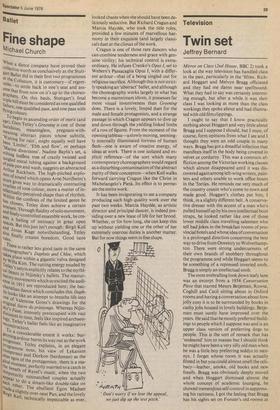Ballet
Fine shape
Michael Church
When a dance company have proved their collective worth as conclusively as the Stuttgart Ballet did in their first two programmes at the. Coliseum, it is customary—if regrettablet o settle back in one's seat and assume that from now on it's up to the choreographs On this basis, Stuttgart's final triple bill must be considered as one qualified failure, one qualified pass, and one pass with king colours. To begin in ascending order of merit (and age), Glen Tetley's Greening is one of those ,rastidi°us, meaningless, pregnant-with" „,leaning abstract
' pieces whose subtitle, Waiting
for rain', might equally well have been 'Limbo', 'Ebb and flow', or perhaps 'Marine diversions'. Nadine Baylis's set, a Willing leafless tree of crazily twisted and tailgted metal tubing against a background ‘,.c
pale Pen and wash, suggests an abstracted
Arthur Rackham. The high-pitched explosiun of sound which opens Arne Nordheim's score gives way to dramatically contrasting swathes of tone colour, more a matter of intel■ectually-perceived shape than of rhythm. has the confines of the limited genre he nas chosen, Tetley does achieve a certain nanI,Nnt. Through fluidity of solo movement, ,-11" finelY-controlled ensemble work, he creates a feeling of intimacy in great open as134ces. But this just isn't enough: Birgit Keil SO Jonas Kage notwithstanding, Tetley unallY creates boredom. Good taste rules.
et There is rather less good taste in the same tTreographer's Daphnis and Chloe, which baw.es Place within a gigantic vulva designed Willa Kim. The rutting energy exuded by etley.s satyrs explicitly relates to the mythial beasts in Nijinsky's ballets. The mastur, eatnrY movements which so excited the audi ence in 1911 are reproduced here; the bac,n.analian dance which concludes this DaphoYs looks like an attempt to breathe life into 0„n.e of Valentine Gross's drawings for the ski Iginal Sacre do printemps. Whereas Nijind;Y's Faun, intensely preoccupied with vast to'stances in time, feels like inspired archaeor gY' Tetley's ballet feels like an imaginative aeoTo a considerable extent it works: burprnriing ardour burns its way out as the work pr„—gresses. Tetley explains, in an elegant (tes'granline note, his view of Lykanion at.ullitress) and Dorkon (herdsman) as the gi'er egos of the protagonists: there is a ma Cal moment Perfectly married to a catch in e tea breath of Ravel's music, when the two aorrit,MrarilY mismatched couples actually do a dream-like double-take on ttl'aLdn other. The ebullient Egon Madsen Bit. !a slightly over-neat Pan, and the lovely gtt Keil, technically impeccable as ever.
looked chaste when she should have been deliciously seductive. But Richard Cragun and Marcia Haydee, who took the title roles, provided a few minutes of marvellous harmony in their exquisite (and largely classical) duet at the climax of the work.
Cragun is one of those rare dancers who can combine tenderness and grace with genuine virility; his technical control is extraordinary. He infuses Cranko's Opus 1, set to Webern's Passacaglia Opus I, with a different ardour—that of a being singled out for religious sacrifice. Although this is not strictly speaking an 'abstract' ballet, and although the choreography works largely in what has become a mainstream idiom, it possesses far more visual inventiveness than Greening does. There is a lovely, limpid duet for the male and female protagonists, and a strange passage in which Cragun appears to dive up and down through the yielding linked limbs of a row of figures. From the moment of the opening tableau—aslowly moving, seemingly internally illuminated fortress of human flesh—one is aware of creative energy, of ideas at work. There is one isolated and explicit reference—of the sort which many contemporary choreographers would regard as a disturbing contamination of the abstract purity of their conception— when Keil walks forward carrying Cragun like the Christ in Michelangelo's Pieta. Its effect is to permeate the entire work.
It has been invigorating to see a company producing such high quality work over the past two weeks. Marcia Haydee, as artistic director and principal dancer, is indeed presiding over a new lease of life for her brood. Whether, or for how long, she can keep this up without yielding one or the other of her extremely onerous duties is another matter. But for now things seem in fine shape.


































 Previous page
Previous page